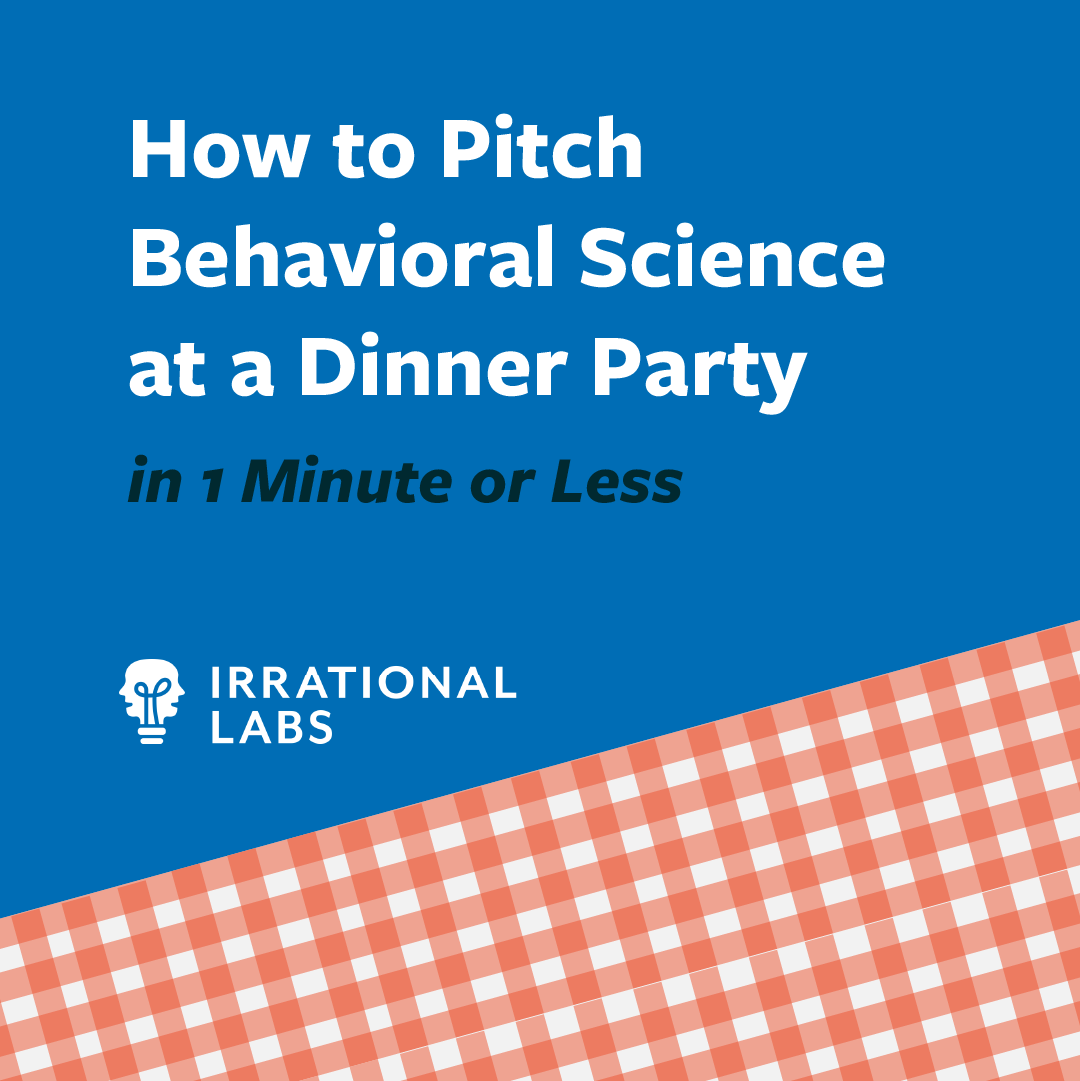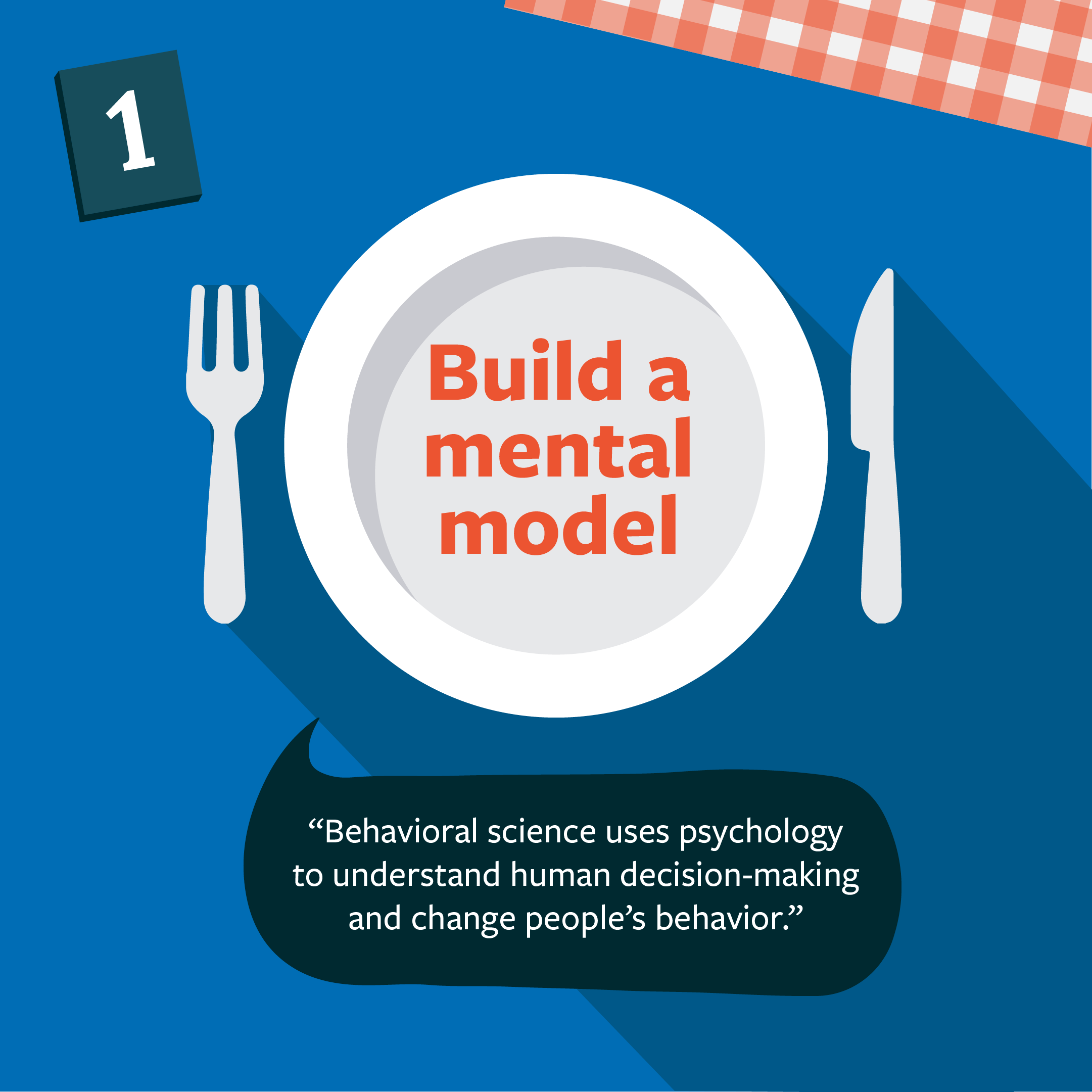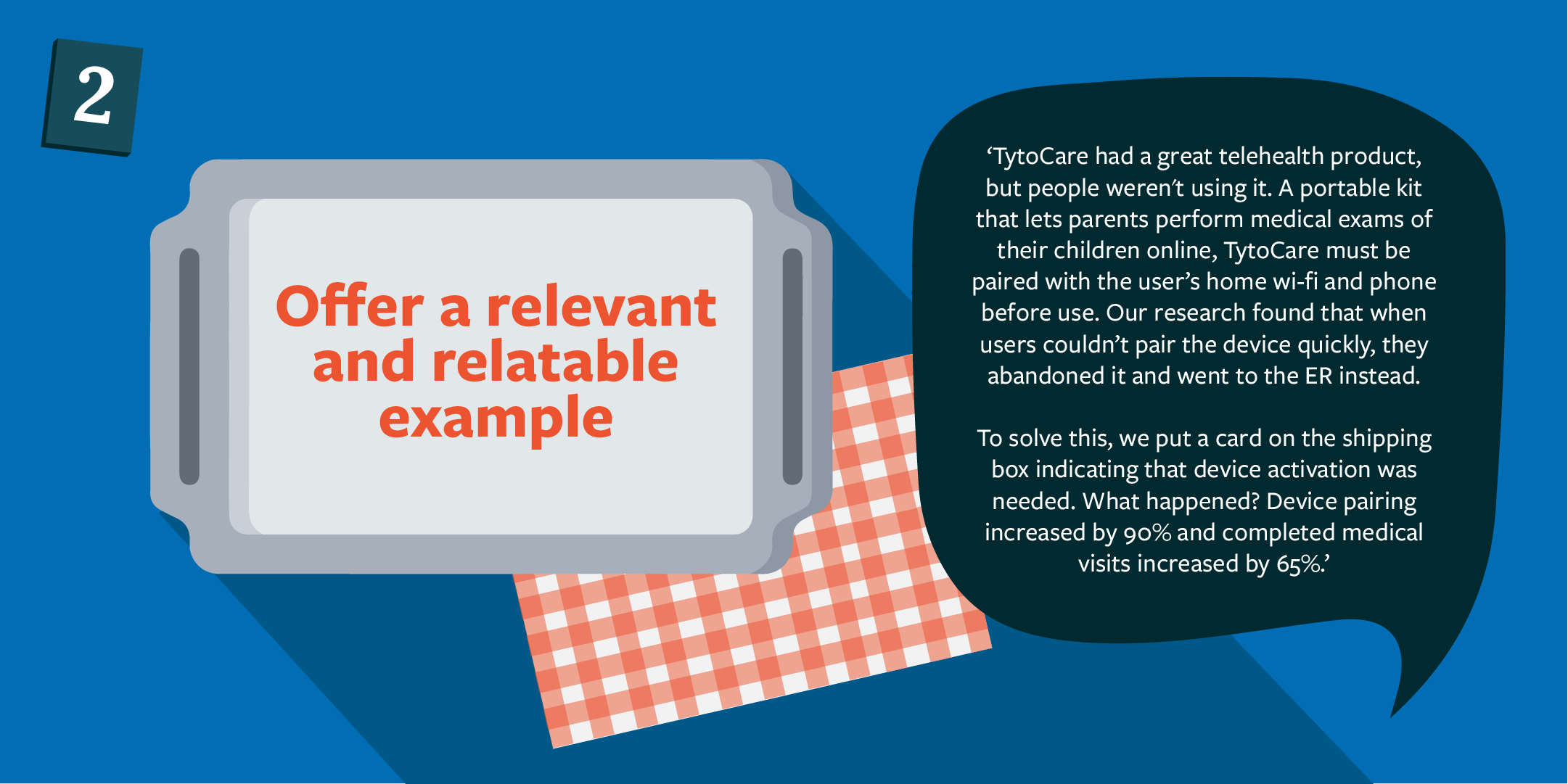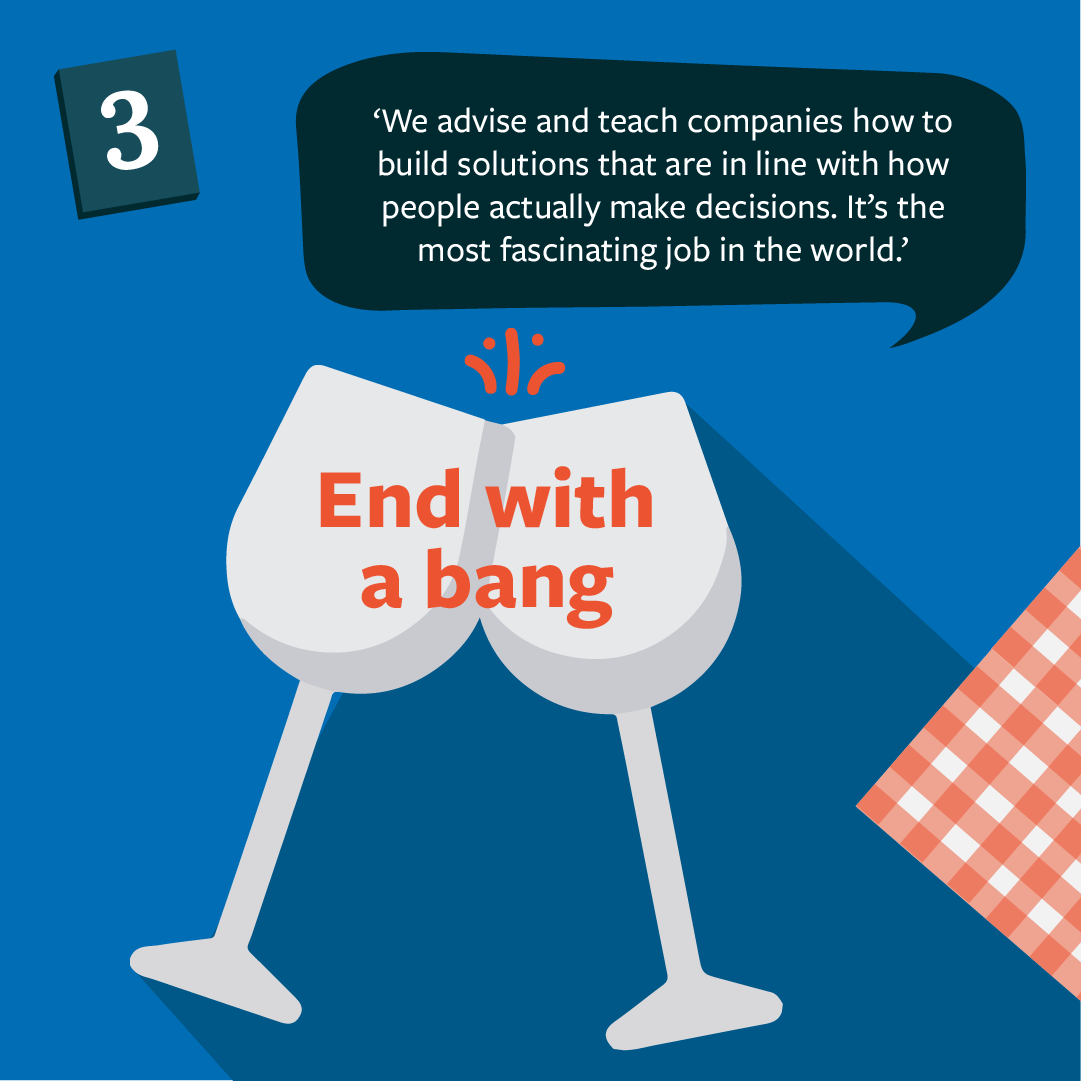Explaining behavioral science is hard, especially when your mouth is full. A common dinner party question like ‘What do you do for work?’ quickly leads to a second question: ‘What is behavioral science?
Before you know it, you’re offering multiple definitions of behavioral science, explaining the many nuances of your work, and going off on countless tangents. Real-world applications swirl into hypotheticals and case study results. And quicker than you can say ‘cognitive bias,’ you’ve lost your audience. Why is explaining behavioral science in plain language so challenging?
I decided to tackle this–by experimenting with dinner party pitches that would convey what behavioral science is, and why you need it, in under 60 seconds.

Behavioral Science: It’s Complicated
One answer to why explaining behavioral science is difficult: behavioral science is complex because people are complex. What’s more, the field has operated without a clear or unified definition for years.
But ultimately, every job is a sales job—whether we signed up to be salespeople or not (Don’t believe me? Read Daniel Pink’s To Sell is Human). And if we want our field to grow and thrive, even behavioral scientists need a compelling dinner party pitch to share the value of our work.
So, how can we create a pitch that is short, simple, and compelling? And how do we do this in a language that even the non-nerds of the world can understand?
Explaining Behavioral Science: The Perfect Pitch in 3 Steps
Irrational Labs has always cared about explaining behavioral science in plain language. But recently, my curiosity got the best of me. So I took matters into my own hands with a very unofficial—and spare-time-only—research project.
That’s right: I spent three months testing various dinner-party pitches with friends and family. I may have driven my loved ones crazy in the process—but my research led to some valuable insights. For example: rambling is never helpful. And as it turns out, the checklist for a perfect dinner party pitch is surprisingly short.
Below, I’ll break down the three key steps to creating a compelling pitch for behavioral science. A bonus: you can put it all together in one minute or less to make a short—and sweet—sell on our amazing field.
Step 1: Build a Mental Model
Consciously or not, people associate most jobs with a specific ‘mental model,’ or conception of how something works. For example, if you ask someone about their job and they say they’re an ‘engineer,’ ‘lawyer,’ or ‘teacher,’ you know roughly what their job entails.
But when you say you’re a behavioral scientist, you’re liable to get blank stares. The mental model for what you do doesn’t exist—so it’s your job to create it.
To do this, you’ll want to steer clear of jargon and minutiae. Instead, use more familiar concepts like ‘psychology’, ‘A/B testing’, or ‘UX/UI research.’ Here’s how your explanation might sound:
‘Behavioral science uses psychology to understand decision-making and change behavior.’
To clarify: like UX/UI researchers, behavioral scientists seek to understand people’s choices and get them to behave in certain ways. Unlike them, though, they rely more on quantitative measurement—and apply the insights not just to product, but also to marketing, policy, and strategy.
See how much clearer that was? Once you know what behavioral science is, it’s also easier to grasp what it isn’t.

Step 2: Give a Relevant (& Relatable) Example
Nothing shows the power of behavioral science quite like a good real-world example. So once you’ve established a mental model for the field, you’ll want to offer an example that hits home for your listener. Remember to personalize it—this will help your audience pay attention.
Also, keep your example tangible. Relay real results that improved a process, product, or service. Citing hard facts removes ‘ambiguity aversion,’ undercutting assumptions that behavioral science is phony.
Oh, and by all means: name-drop. When people learn that companies like Uber, Microsoft, and Google are using behavioral science, it’s an easier sell. We tend to trust these companies and assume they’re onto something. Pro tip: This ‘validity boost’ is especially useful when you’re explaining behavioral science to someone who has never heard of it.
What follows are my go-to examples from specific fields. Pick the one that best suits your audience and you’ll have them reading Dan Ariely in no time.

Finance
SaverLife’s mission is to help people make saving money a habit, and to promote short-term savings. To succeed, users must link their bank accounts to the app. Pre-intervention, SaverLife had a bank link rate of roughly 26%. To promote bank linking, our colleagues at the Common Cents Lab moved bank linking from the last step in the process—after tedious demographic and financial health questions—to step 2.
What happened? Bank linking increased by 323%. No need to offer money or change requirements—just adjusting the sign-up flow to make bank-linking easier led to an estimated $5M in savings in 2019 alone.
Technology
In 2018, Uber launched Express POOL—a function letting users ride-share. But riders were canceling trips due to extra wait times between requesting and matching with cars and the need to walk to the pickup location.
To change this, the behavioral science team showcased each granular step behind the scenes, a tactic called ‘operational transparency.’ This reduced post-request cancellations by 11%.
Healthcare
TytoCare had a great telehealth product, but people weren’t using it. A portable kit that lets parents perform guided medical exams of their children online, TytoCare requires pairing with the user’s wi-fi and phone before first use. This caused a problem: parents would pull the device out to connect with a doctor—and stop midway through. Why?
Our research found that they were overwhelmed by their child’s illness. When they couldn’t pair the device quickly, they went to the ER instead. The solution: get parents to pair the device before someone gets sick.
To do this, we put a card on the shipping box indicating that device activation was needed—much like the stickers on new credit cards. What happened? Device pairing increased by 90% and completed medical visits increased by 65%.
Organizational Change
A call center had an unusually high employee turnover rate of 50%–70%. Pay raises and additional employee benefits didn’t solve the problem, so the company tried tweaking its onboarding. One group of new hires received the standard training with an extra hour focusing on company identity. A second group received the same training, but with an extra hour focusing not on the company, but on the employees themselves.
After seven months, employees from group 2 were 250% more likely than those from group 1 to still be with the company. Why? Group 2 received ‘belonging cues’ during onboarding—which built a deeper identity and connection with the company early on. When people feel valued, they stick around.
Step 3: End with a Bang (Hello, Peak-End Rule)
Now that you’ve solidified your mental model with an example, let’s bring it home. The ‘peak-end rule’ holds that when remembering an experience, people most strongly recall the intense positive or negative moments (the ‘peaks’) and the final moment (the ‘end’). So, your main goal here is to finish strong. You want your listener to leave the conversation thinking, ‘This is a cool job!’ — or even better, ‘I need this at my company.’
To end with a bang, I say something like this:
‘We apply insights like these for better problem-solving. So often, companies have non-psychologists looking at problems in ways that are unnecessarily long and complicated. But behavioral scientists approach challenges in marketing, product, and policy with a basic understanding of human decision-making. We advise and teach companies to use this knowledge to build solutions that work—and solutions that are in line with how people actually make decisions. It’s the most fascinating job in the world.’

Wrapping Up: The Cherry on Top (Of Your Perfect Pitch)
Inspired to craft a killer pitch for behavioral science at your next dinner party? I’m still perfecting mine, but I no longer wince when people ask me ‘What do you do for work?’
Explaining behavioral science, it turns out, doesn’t have to be complicated. You just have to follow behavioral science ‘first principles’: leveraging mental models, keeping things simple, and personalizing examples while being concrete—and remembering that the ending matters.
After all, the smartest among us can explain things in the simplest terms—so it’s time we learn to do our field justice in one minute or less.
Need help applying behavioral science to improve your product? Get in touch to learn more about our consulting services. Or learn more behavioral science by joining one of our bootcamps.
